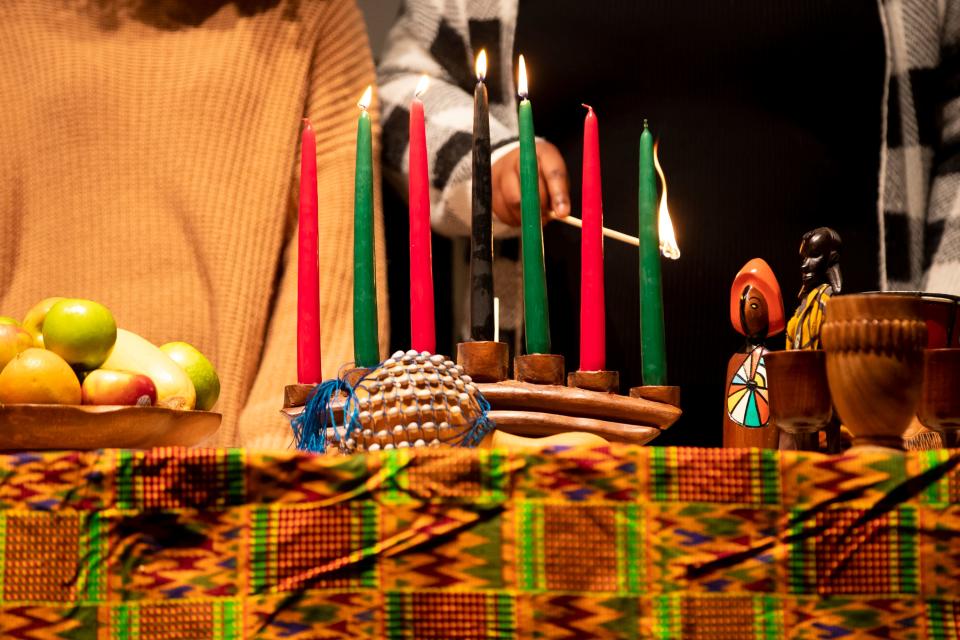Kwanzaa: Everything you need to know about the Pan-African holiday
- Oops!Something went wrong.Please try again later.
Christmas and Hanukkah are not the only holidays celebrated in the month of December.
A relatively modern holiday bridges the gap between African-Americans and their African heritage, a celebration known as Kwanzaa.
Here's everything you need to know about the Pan-African holiday.

When did it start?
The origin of the celebration dates back to 1966. Maulana Karenga, professor and chairman of Africana Studies at California State University, created it to be the first pan-African holiday.
The celebration honors African harvest festival traditions from various parts of Africa, including West and Southeast Africa.
The term "Kwanzaa" is a Swahili word which means "fresh fruit."
More: Before Janus, King Zulu reigned in Monroe
How is it celebrated?
Kwanzaa is observed Dec. 26 through Jan. 1.
Northeast Louisiana Delta African-American Heritage Museum Executive Director Ross Slacks said the holiday is celebrated after Christmas because most people see Christmas as the most religious holiday of the year.
"Karenga wanted to do something in conjunction with that," Slacks said. "Karenga wanted to have a festival that was dedicated to a specific principle and each principle is marked by the seven candles."
Each of the seven days of Kwanzaa is celebrated with one of seven principles.
Umoja (Unity) – To strive for and maintain unity in the family, community, nation and race
Kujichagulia (Self-determination) – To define ourselves, name ourselves, create for ourselves, and speak for ourselves.
Ujima (Collective work and responsibility) – To build and maintain our community together and make our brothers' and sisters' problems our problems and to solve them together.
Ujamaa (Cooperative economics) – To build and maintain our own stores, shops, and other businesses and to profit from them together.
Nia (Purpose) – To make our collective vocation the building and development of our community in order to restore our people to their traditional greatness.
Kuumba (Creativity) – To do always as much as we can, in the way we can, in order to leave our community more beautiful and beneficial than we inherited it.
Imani (Faith) – To believe with all our heart in our people, our parents, our teachers, and the righteousness and victory of our struggle.
The holiday has seven primary symbols, which represent the seven principles.
Mazao (Crops) – Symbolic of African harvest celebrations and the reward of productive and collective labor
Mkeka (The Mat) – Symbolic of our tradition and history and therefore, the foundation on which we are built
Kinara (The Candle Holder) – Symbolic of our roots, our parent people – continental Africans
Muhindi (Corn) - Symbolic of our children and our future which they embody
Kikombe cha Umoja (Unity Cup) – Symbolic of the foundational principle and practice of unity which makes all else possible
Mishumaa Saba (The Seven Candles) – Symbolic of the Seven Principles, the matrix and minimum set of values which African people are urged to live by in order to rescue and reconstruct their lives in their own image and according to their own needs
Zawadi (The Gifts) – Symbolic of the labor and love of parents and the commitments made and kept by the children
According to Kwanzaa.org, on the first day of Kwanzaa, a central location in the home for the Kwanzaa set is chosen. A table is then spread with an African cloth where the mat will be placed and all of the other symbols will placed each of the seven days. The candle holder is placed on the mat and the the seven candles are placed in the kinara.
The colors of Kwanzaa are black, green and red; black represents the people, red represents their struggle and green represents the future and hope that comes from their struggles. There is one black candle, three red candles and three green candles, each candle representing the Seven Principles of Kwanzaa.
The holiday, which became popular during the 1980s and 1990s, is celebrated primarily in the United States, Canada and the Caribbean.
The museum annually celebrates the Pan-African Holiday with a special program, which includes music, keynote speakers and an overview of the Seven Principles of Kwanzaa. This year's program was held Dec. 19.
"We go over the Seven Principles with each person who is not familiar with Kwanzaa and let them understand what is means and how we should do it and what it marks," Slacks said.
The Northeast Louisiana Delta African-American Heritage Museum is located at 1501 Chennault Park Drive in Monroe and is open from 10 a.m. to 3 p.m. Tuesday through Saturday. Admission is $5 for adults and $3 for children 17 and under.
Follow Ian Robinson on Twitter @_irobinson and on Facebook at https://bit.ly/3vln0w1.
Support local journalism by subscribing at https://cm.thenewsstar.com/specialoffer.
This article originally appeared on Monroe News-Star: Here's what you need to know about Kwanzaa

